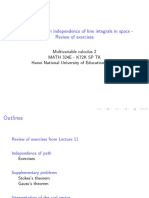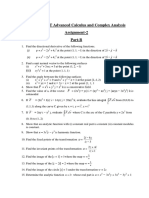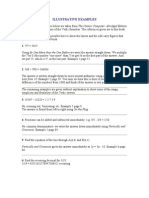24MA101 Unit5_Multiple Integrals
Uploaded by
skdhakhil924MA101 Unit5_Multiple Integrals
Uploaded by
skdhakhil9Unit V - VECTOR CALCULUS
PART-A
→
1. Find ∇.
2. For what value of ‘k’, rkr⃗ is solenoidal.
3. Find ‘a’ so that the vector A⃗ = (ax − y + x)ı⃗ − (2xy)ȷ⃗ is irrotational.
4. State Green’s theorem in a plane.
5. State Stoke’s theorem.
6. Prove that divcurlF⃗ = 0⃗ .
7. State Gauss- divergence theorem.
8. Determine whether F⃗ = (2xy + z )ı⃗ + (x )ȷ⃗ + (3xz )k⃗ is a conservative force field.
9. Find the unit normal vector to the surface xy+ yz +zx =3 at (1,1,1).
10. Find such that F⃗ = (3x − 2y + z)ı⃗ + (4x + αy − z)ȷ⃗ + (x − y + 2z)k⃗ is solenoidal.
11. Find a unit normal to the surface x + y − 2z = −3 at (1,2,-1).
12. What is the greatest rate of increase of ∅ = xyz at (1,0,3).
13. Find the maximum directional derivative of ∅ = zyx + 4xyz at (1,-2,1).
14. If ∅ = 3xy − yz, find grad∅ at (1,1,1).
15. Find ∇r where r⃗ = xı⃗ + yȷ⃗ + zk⃗and r = |r⃗|.
16. Find the value of a, b, c so that the vector F⃗ = (x + y + az)ı⃗ + (bx + 2y − z)ȷ⃗ + (−x + cy +
2z)k⃗ may be irrotational.
PART-B
1. Find the directional derivative of ∅ = x yz + 4xz at (1,1,1) in the direction of ⃗ı + ⃗ȷ + k⃗.
2. Find the constants ‘a’ and ‘b’ so that the surfaces is ax 3 by 2 z a 3 x 2 and 4 x 2 y z 3 11
may cut orthogonally
at the point (2,-1,-3).
3. Show that F 6 xy z 3 i 3x 2 z j 3xz 2 y k is irrotational. And hence find its scalor
potential.
4. Verify Green’s theorem in the plane for 3x 8 y 2 dx 4 y 6 xy dy where C is the
2
boundary of the region bounded by x 0, y 0 & x y 1.
5. Verify Green’s theorem in the plane for xy y 2 dx x 2 dy where C is the closed curve of
C
the region bounded by y x 2 & x y.
6. Verify Gauss Divergence theorem for F x 2 yz i y 2 xz j z 2 xy k and S is the
surface bounded by 0 x a, 0 y b, 0 z c.
7. Verify Gauss Divergence theorem for F x 2 i z j yzk over the cube formed by the
planes x 1, y 1, z 1.
8. Verify Gauss Divergence theorem for F 4 xzi y 2 j yzk over the cube bounded by
x 0, x 1, y 0, y 1, z 0 and z 1.
9. Verify Stoke’s theorem for F y z 2 i yz 4 j xzk over the surface of the cube
x 0, x 2, y 0, y 2, z 0 and z 2.
10. Verify Stoke’s theorem for F x 2 y 2 i 2 xy j taken around the rectangle bounded by
the lines x a, y 0, y b.
You might also like
- National Institute of Technology Calicut Department of Mathematics MA 1001D: Mathematics 1No ratings yetNational Institute of Technology Calicut Department of Mathematics MA 1001D: Mathematics 12 pages
- 18 MAB 102 T Advanced Calculus and Complex Analysis-Assignment-2 PDFNo ratings yet18 MAB 102 T Advanced Calculus and Complex Analysis-Assignment-2 PDF3 pages
- MA5252 Engineering Mathematics-II Unit - INo ratings yetMA5252 Engineering Mathematics-II Unit - I3 pages
- Question Bank Partial Differentiation: y X y XNo ratings yetQuestion Bank Partial Differentiation: y X y X10 pages
- Advanced Calculus: Topics in Vector CalculusNo ratings yetAdvanced Calculus: Topics in Vector Calculus36 pages
- Consequences of Global Warming:: 1. Melting of Glaciers: The Melting of Glaciers Will Create Plethora ofNo ratings yetConsequences of Global Warming:: 1. Melting of Glaciers: The Melting of Glaciers Will Create Plethora of5 pages
- Sistema de Riego Automático Con ArduinoNo ratings yetSistema de Riego Automático Con Arduino12 pages
- AC 14002 Flight Dispatcher Training and Approval20200814 FinalNo ratings yetAC 14002 Flight Dispatcher Training and Approval20200814 Final32 pages
- 254522-FR-EN-HYDRUS Remote Control Guide Type 6 ENNo ratings yet254522-FR-EN-HYDRUS Remote Control Guide Type 6 EN4 pages
- Customer Satisfaction Towards Cooking Oil - FinalNo ratings yetCustomer Satisfaction Towards Cooking Oil - Final17 pages
- Chapter 22: Current and Resistance: SolutionsNo ratings yetChapter 22: Current and Resistance: Solutions5 pages
- Illustrative Examples of Vedic MathematicsNo ratings yetIllustrative Examples of Vedic Mathematics3 pages
- Elizabeth A. Povinelli - Between Gaia and Ground - Four Axioms of Existence and The Ancestral Catastrophe of Late Liberalism-Duke University Press (2021)No ratings yetElizabeth A. Povinelli - Between Gaia and Ground - Four Axioms of Existence and The Ancestral Catastrophe of Late Liberalism-Duke University Press (2021)201 pages
- PDF of A Scot in The Dark Sarah Maclean Full Chapter Ebook100% (12)PDF of A Scot in The Dark Sarah Maclean Full Chapter Ebook69 pages
- Commerical Invoice: +353 21 4500051 Ap@disc - Ie +353 21 4500051 Ap@disc - IeNo ratings yetCommerical Invoice: +353 21 4500051 Ap@disc - Ie +353 21 4500051 Ap@disc - Ie12 pages
- Lecture - 1 - Molecular Structure of Skeletal Muscle and Function of Nerve-Muscle JunctionNo ratings yetLecture - 1 - Molecular Structure of Skeletal Muscle and Function of Nerve-Muscle Junction16 pages

























































































